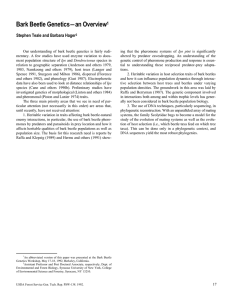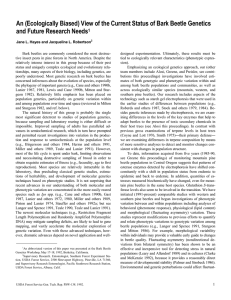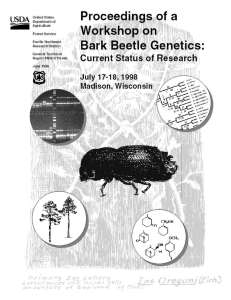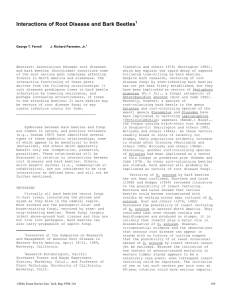Genetic Characters for Bark Beetle Phylogenies James H. Cane 1
advertisement
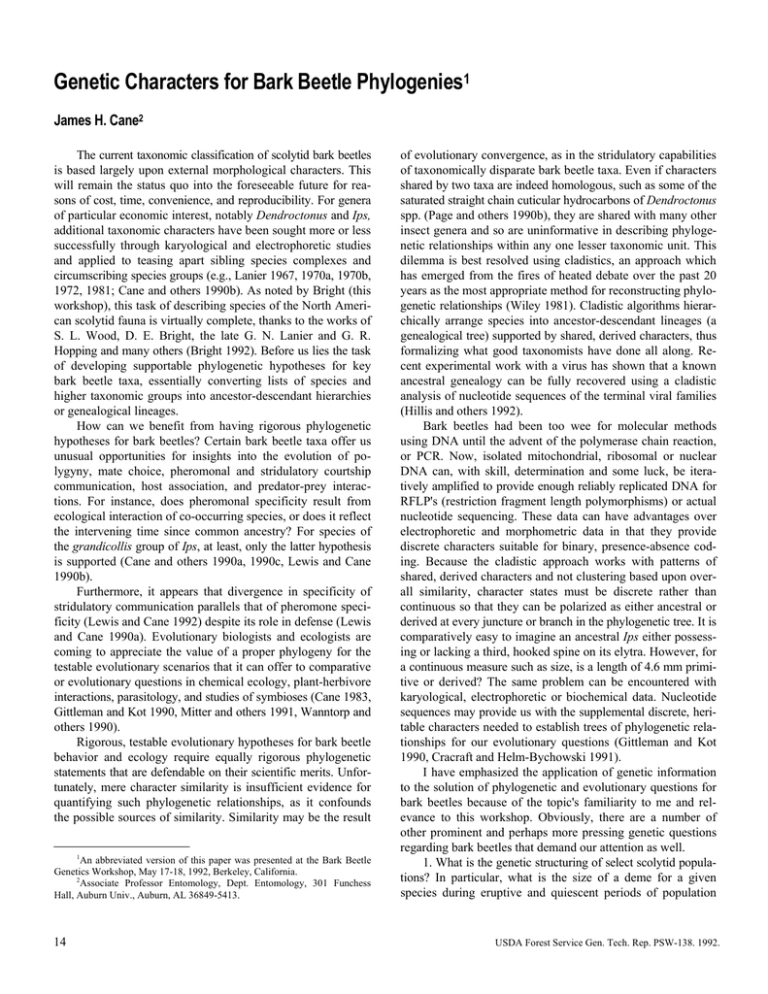
Genetic Characters for Bark Beetle Phylogenies1 James H. Cane2 The current taxonomic classification of scolytid bark beetles is based largely upon external morphological characters. This will remain the status quo into the foreseeable future for rea­ sons of cost, time, convenience, and reproducibility. For genera of particular economic interest, notably Dendroctonus and Ips, additional taxonomic characters have been sought more or less successfully through karyological and electrophoretic studies and applied to teasing apart sibling species complexes and circumscribing species groups (e.g., Lanier 1967, 1970a, 1970b, 1972, 1981; Cane and others 1990b). As noted by Bright (this workshop), this task of describing species of the North Ameri­ can scolytid fauna is virtually complete, thanks to the works of S. L. Wood, D. E. Bright, the late G. N. Lanier and G. R. Hopping and many others (Bright 1992). Before us lies the task of developing supportable phylogenetic hypotheses for key bark beetle taxa, essentially converting lists of species and higher taxonomic groups into ancestor-descendant hierarchies or genealogical lineages. How can we benefit from having rigorous phylogenetic hypotheses for bark beetles? Certain bark beetle taxa offer us unusual opportunities for insights into the evolution of po­ lygyny, mate choice, pheromonal and stridulatory courtship communication, host association, and predator-prey interac­ tions. For instance, does pheromonal specificity result from ecological interaction of co-occurring species, or does it reflect the intervening time since common ancestry? For species of the grandicollis group of Ips, at least, only the latter hypothesis is supported (Cane and others 1990a, 1990c, Lewis and Cane 1990b). Furthermore, it appears that divergence in specificity of stridulatory communication parallels that of pheromone speci­ ficity (Lewis and Cane 1992) despite its role in defense (Lewis and Cane 1990a). Evolutionary biologists and ecologists are coming to appreciate the value of a proper phylogeny for the testable evolutionary scenarios that it can offer to comparative or evolutionary questions in chemical ecology, plant-herbivore interactions, parasitology, and studies of symbioses (Cane 1983, Gittleman and Kot 1990, Mitter and others 1991, Wanntorp and others 1990). Rigorous, testable evolutionary hypotheses for bark beetle behavior and ecology require equally rigorous phylogenetic statements that are defendable on their scientific merits. Unfor­ tunately, mere character similarity is insufficient evidence for quantifying such phylogenetic relationships, as it confounds the possible sources of similarity. Similarity may be the result 1 An abbreviated version of this paper was presented at the Bark Beetle Genetics Workshop, May 17-18, 1992, Berkeley, California. 2 Associate Professor Entomology, Dept. Entomology, 301 Funchess Hall, Auburn Univ., Auburn, AL 36849-5413. 14 of evolutionary convergence, as in the stridulatory capabilities of taxonomically disparate bark beetle taxa. Even if characters shared by two taxa are indeed homologous, such as some of the saturated straight chain cuticular hydrocarbons of Dendroctonus spp. (Page and others 1990b), they are shared with many other insect genera and so are uninformative in describing phyloge­ netic relationships within any one lesser taxonomic unit. This dilemma is best resolved using cladistics, an approach which has emerged from the fires of heated debate over the past 20 years as the most appropriate method for reconstructing phylo­ genetic relationships (Wiley 1981). Cladistic algorithms hierar­ chically arrange species into ancestor-descendant lineages (a genealogical tree) supported by shared, derived characters, thus formalizing what good taxonomists have done all along. Recent experimental work with a virus has shown that a known ancestral genealogy can be fully recovered using a cladistic analysis of nucleotide sequences of the terminal viral families (Hillis and others 1992). Bark beetles had been too wee for molecular methods using DNA until the advent of the polymerase chain reaction, or PCR. Now, isolated mitochondrial, ribosomal or nuclear DNA can, with skill, determination and some luck, be itera­ tively amplified to provide enough reliably replicated DNA for RFLP's (restriction fragment length polymorphisms) or actual nucleotide sequencing. These data can have advantages over electrophoretic and morphometric data in that they provide discrete characters suitable for binary, presence-absence cod­ ing. Because the cladistic approach works with patterns of shared, derived characters and not clustering based upon overall similarity, character states must be discrete rather than continuous so that they can be polarized as either ancestral or derived at every juncture or branch in the phylogenetic tree. It is comparatively easy to imagine an ancestral Ips either possess­ ing or lacking a third, hooked spine on its elytra. However, for a continuous measure such as size, is a length of 4.6 mm primi­ tive or derived? The same problem can be encountered with karyological, electrophoretic or biochemical data. Nucleotide sequences may provide us with the supplemental discrete, heri­ table characters needed to establish trees of phylogenetic rela­ tionships for our evolutionary questions (Gittleman and Kot 1990, Cracraft and Helm-Bychowski 1991). I have emphasized the application of genetic information to the solution of phylogenetic and evolutionary questions for bark beetles because of the topic's familiarity to me and rel­ evance to this workshop. Obviously, there are a number of other prominent and perhaps more pressing genetic questions regarding bark beetles that demand our attention as well. 1. What is the genetic structuring of select scolytid popula­ tions? In particular, what is the size of a deme for a given species during eruptive and quiescent periods of population USDA Forest Service Gen. Tech. Rep. PSW-138. 1992. cycles? What are the respective rates of gene flow during these periods? Do allele frequencies shift as a result of natural or sexual selection during either part of these population cycles? If there is an oscillation in selective regimes, is its effect roughly reciprocal, such that selection in one phase cancels that in the next? Or do populations gradually change genetically as a result of such cyclical selection? Or is it not selection at all but drift during the phase of population crash that fixes genetic change in populations, the so-called "flush-crash" hypothesis of Hampton Carson? 2. Over what distances do some individuals of a species migrate? Are outbreaks intensified by an influx of beetles from neighboring populations, or do they result from expansion of the local population? Do outbreaks spawn greater proportions of dispersing individuals? USDA Forest Service Gen. Tech. Rep. PSW-138. 1992. 3. It is crucial that we gain an understanding of the relative contributions of environment and inheritance to the variance we see in bark beetle phenotypes, particularly in their produc­ tion, perception and response to semiochemicals. Teale and Hager's work (this workshop) with heritability and covariance in pheromone production and response, and its responsiveness to imposed selection, is some of the first work in this exciting and much-needed line of investigation. 4. We must not allow ourselves to become complacent or flip about the methodological hurdles that lie in wait of bark beetle biologists wishing to make use of the tools of molecular biology and genetics. As noted by Seybold, by Alosi, and by Anderson (this workshop), we can benefit from the genetic and molecular knowledge already accrued for other insect taxa in our hunt for methods to answer our own genetic questions about scolytids. 15
